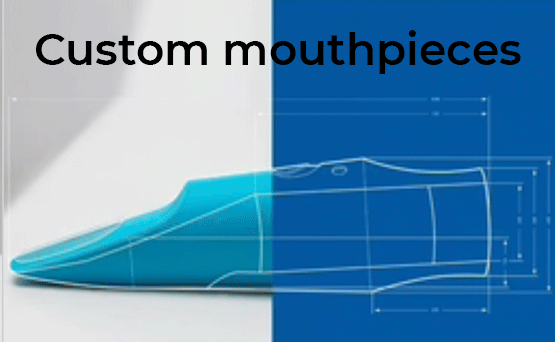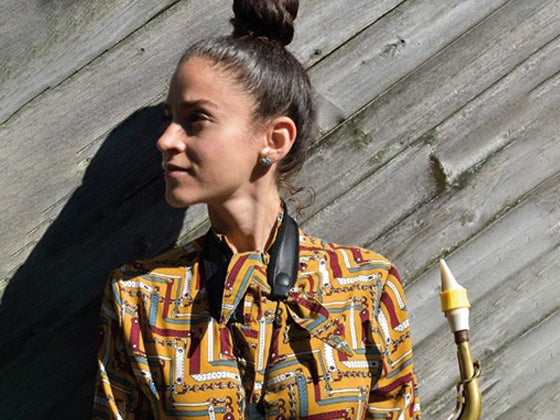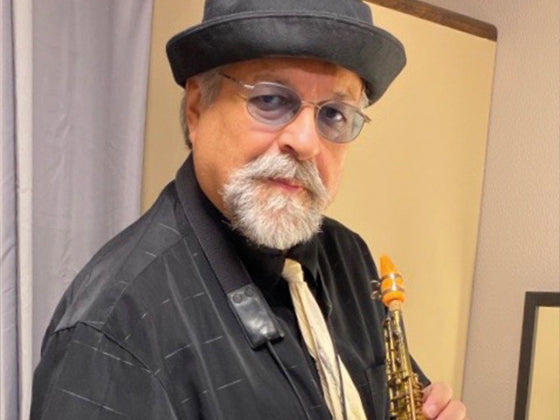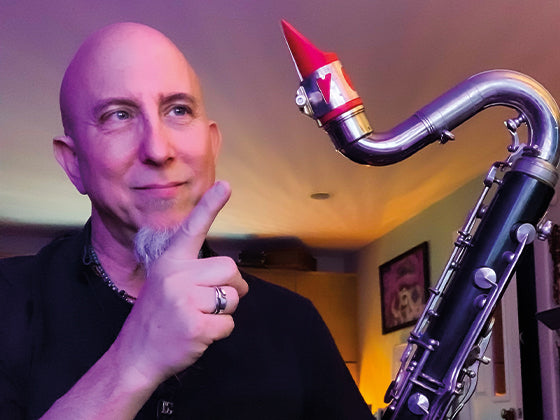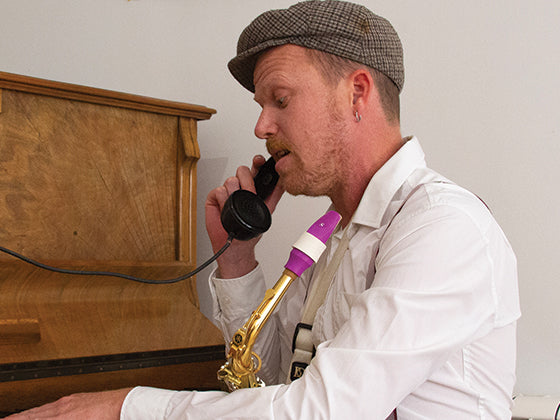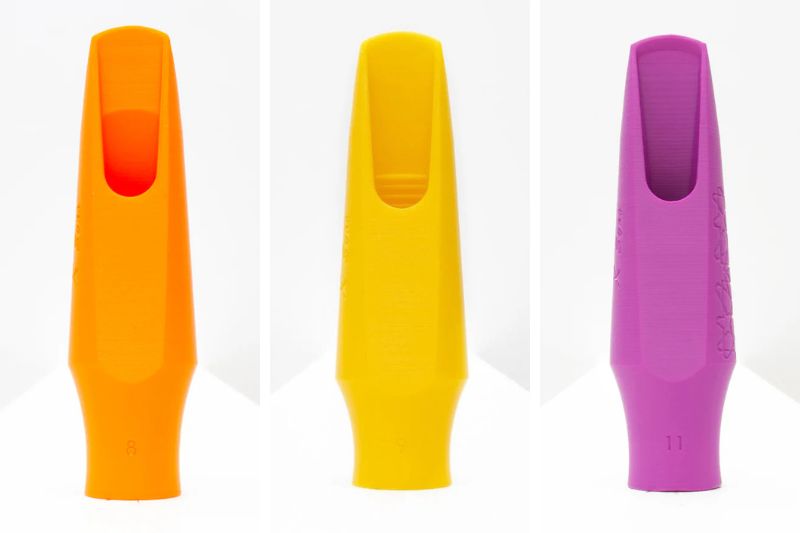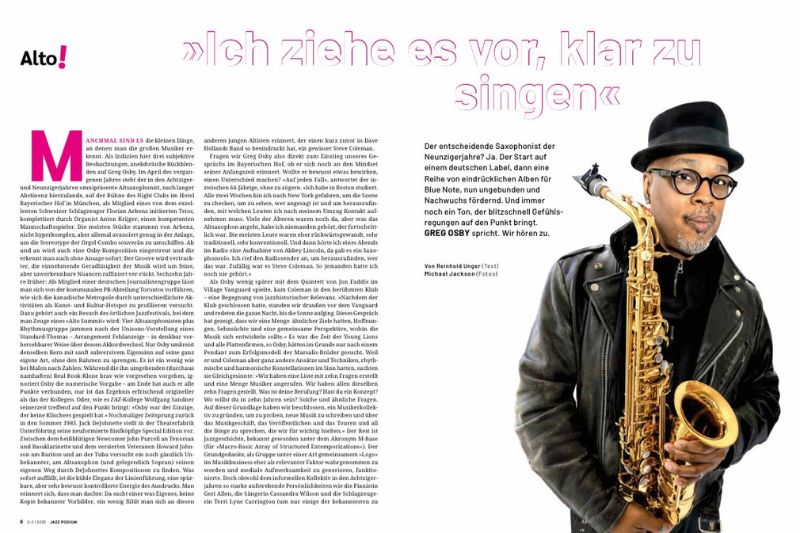A few years ago we wrote an article about the role of the baffle on the mouthpieces. The article is a nice overview on the general role of the baffle. It's better to start by reading it to get the basics. But this time I wanted to make an exhaustive list of all the baffles we use at Syos and what is their impact on the sound and the playing characteristics. Let's go!

The straight baffle
This one is the simplest: it's a straight line between the tip and the chamber. This is the most resistant type of baffle (we could do something more resistant with a concave baffle but we haven't used that so far). We use this type of baffle mostly for classical mouthpiece. Like on the Sarah Dunbar's signature mouthpiece for alto.
The step baffle
This baffle is made of two straight lines, as shown in the picture. What's really interesting with that baffle is that, depending of the measurements of the two lines, it can make a mouthpiece really bright and powerful or it can make it dark. The longer and the closer to the reed the first line is, the brighter and the more powerful the mouthpiece is. It's what we call a high step baffle. It is this type of baffle that is used for the Tenor Scott Paddock's signature or the Spark for tenor.

But we can also keep this baffle low, and it will give a dark mouthpiece but with a nice projection. Coupled with a large chamber we will have a dark mouthpiece with a large sound, like the Dan Forshaw's signature mouthpiece. And couple with a small chamber, we will get a dark mouthpiece with a centered sound like the Max Ionata's signature mouthpiece.
The medium step baffle, coupled with a medium chamber, gives a really balanced mouthpiece, like the Steady on tenor sax.
⚠️ The high step baffle is difficult to control, it can easily squeak. If you are a beginner, you should go for another type of baffle.

The circular baffle
The circular baffle is made of several circular arcs of different lengths and diameters, touching each other in order to connect the tip to the chamber. Like the step baffle, depending on the size of the different arcs and if they are close or not to the reed, this baffle can be really powerful or really resistant. It will never be as powerful and bright as the high step baffle though.
On tenor, we use it mostly in its resistant configuration, like in the Tivon Penicott's signature model. On alto, we like to use high circular baffles to give a nice punch to the sound, like in the Greg Osby's signature mouthpiece.
The curved baffle
For the baffle we use a spline to make the junction between the tip and the chamber. This baffle can also be high or low but even in the high configuration it won't be as powerful as the step baffle and the circular baffle. So this baffle is more used for dark or balanced mouthpieces. We use it on the Smoky for alto for example.

The rollover baffle
We designed this baffle for the first time for Daro Behroozi's signature mouthpiece for tenor sax. It's different from the traditional rollover baffle because on our design it has a small bump at the tip which gives an extra punch. This baffle can almost be as powerful as the high step baffle but it won't be as bright so it's really nice to have a really powerful mouthpiece but without having a sound too bright and nasal. Also, this baffle is way easier to control than the step baffle. So it's a good choice if you are a beginner and want a powerful mouthpiece.
The spheric baffle
This baffle is a baffle we only use on the baritone at the moment. It's a straight line that ends with a small diameter circular arc. This baffle gives great balanced mouthpieces on baritone. That's why we use it for the Baritone Steady.

The ridges
We put what we called "the ridges" on some baffles like in the Tomoaki Baba's signature mouthpiece. As we saw previously, when we want to had power to a mouthpiece, we need to make the baffle higher. But the higher the baffle, the brighter the mouthpiece. So these ridges, that we have patented, gives more power to the sound but without bringing the brightness.

The special one: the stair baffle
This baffle is a little weird. It's composed of several step baffles, which makes the baffle look like a staircase. This baffle is difficult to control: depending on the angle you blow you air inside the mouthpiece, the mouthpiece can be really powerful or really resistant. So it looks cool but it's not ideal, that's why we don't use it anymore. Nevertheless, Terry Edwards fell in love with that baffle when I made him try at Rock en Seine in 2017 when he was playing with PJ Harvey, and he is still playing on that mouthpiece 8 years later!

